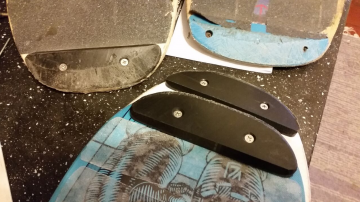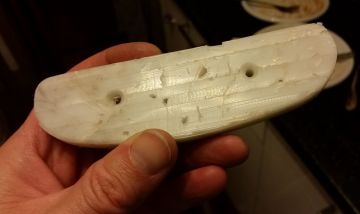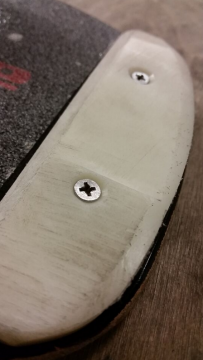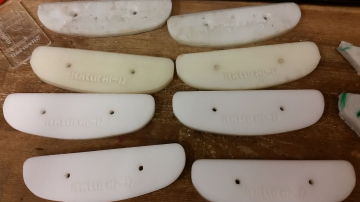Freestyle Skateboard Skidplates
| Freestyle Skateboard Skidplates | |
|---|---|
| Primary Contact | Michael Erskine |
Freestyle skateboards typically have skidplates (a.k.a. "tail-savers" or "tail-skids") to reduce the frictional wear on the underside of the deck nose and tail. Avoiding wear on the nose and tail is important for freestyle boards as there are many tricks that excert a lot of force on the ends of the board which, if worn down too far, will delaminate and ruin the deck. Freestyle skidplates are typically plastic or wood and are bolted or screwed to the deck. Plastic is preferred as it offers less friction. There are very few commercial outlets for freestyle skidplates, mostly from specialist skate shops in the USA and Germany.
-
Various Freestyle Skateboard Tailskids
Goals
- suitable for use (durable)
- cheap
- easy to make
- consistent quality
- sustainable
We (i.e. the UK Freestyle Skateboarding community) are looking for an alternative, convenient source of consumable skidplates. Resistance to wear needs to be balanced with cost and convenience. Cost is of course a product of both materials price and manufacturing labour time. In this regard, the two initial prototypes currently produced are probably the most expensive skidplates every made! As we are all aware, one-off prototypes are rarely representative of a commercially viable product!
A further goal, which is important to me in the International Freestyle Skateboarding Community, is to not unduly affect the revenue streams of other grass-roots freestyle skate companies. It is for this reason that I promise to only ever produce these on a not-for-profit basis, perhaps as sponsorship only.
Balance: -
- buying in high quality engineering plastics that can be quickly manufactured into skidplates
- recycling readily-available HDPE into stock that can be "reasonably" quickly manufactured into skidplates
Prototypes
Materials: -
| Material | Info | Laser-safe | Machinable | Price | Testing |
|---|---|---|---|---|---|
| HDPE | plastipedia wp | Yes but "melty" | Yes but slightly "chewy" | Low | Underway |
| Polypropylene | wp | Yes but "melty" | Yes (needs testing) | Unknown | None |
| Acetal (Delrin) | plastipedia wp | Yes (excellent) | Yes (excellent) | Fairly High | Underway |
| LDPE | wp | Unknown | Unknown | Unknown | None |
| PTFE (Teflon) | wp | Unknown | Yes (excellent) | Crazy Expensive | None |
| Nylon 66 | plastipedia wp | Unknown | Yes (excellent) | Unknown | None |
"Milky-Milky" Recycled HDPE prototype 1
- Recycled from plastic milk bottles - See HDPE Processing
- Rendered in toaster oven at 230 degrees C
- Machined plate on Bridgeport to 8mm
- outline and fixing drill holes etched on laser cutter
- outline cut on bandsaw
- fixing holes drilled on pillar drill
- bevel (yet to be formed)
-
Almost Finished Prototype 1
"Natural-D" Delrin prototype 1
- engineering 8mm Delrin plate offcut
- laser cut outline and drill holes at 7mm/sec
- re-drill and countersink of bolt holes on pillar drill
- bevelled edge made on disk sander
- testing in progress - going well!
-
Testing in progress
-
HDPE and Delrin prototypes etched with logos
Current Skidplate Sources
eBay search terms: -
- Skateboarding category
- NOS Powell Tailbone
- skid plate in Skateboarding
- tailsaver, tail-saver, tail saver, tailbone, tail-bone, tail bone, tailskid, tail-skid, tail skid, skidplate, skid-plate skid plate
International skate shops



